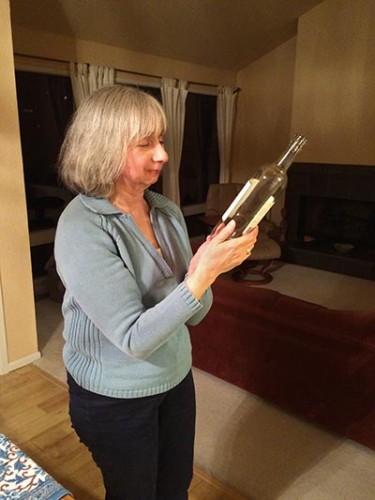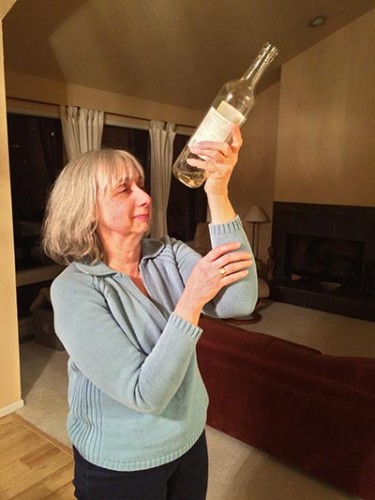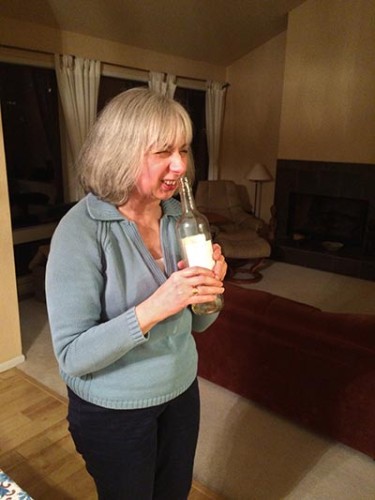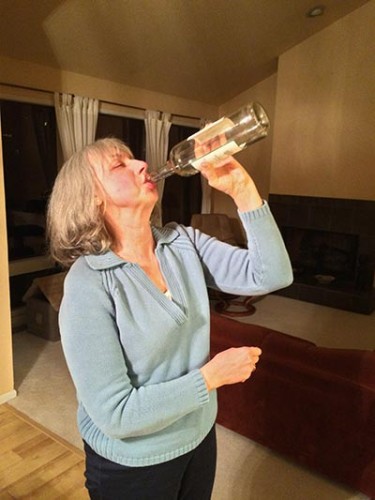Cindy is unable to edit a post tonight (for reasons that will soon become obvious), so your intrepid site admin is standing in. This episode presents a basic tutorial on cultivating one’s palate to the pleasures of the noble grape, in its fermented form. When Cindy was an undergraduate, she completed the wines course in the Cornell University School of Hotel Administration. Furthermore, her family hails from rural Upstate New York, a region famous for producing women with low morals and hollow legs. So she clearly qualifies as a World Authority on alcoholic beverages.
Step One: Study the Label
If you have an interest in oenophilia (and live in a state where it is legal), you will learn to read a wine label like a book. With experience you will learn how to recognize the most important features indicative of a quality product: how much wine is in the bottle, what percentage of it is delicious alcohol, the price, etc. Don’t be discouraged if the text is in a foreign language. For example. the term “appellation” simply refers to certain regions of France. Beverages of similar or superior merit are made by many small producers in the US Appalachians.
Look for: words like jumbo, economy, costco, fortified
Avoid: words like windex, prestone, isopropyl, welch’s
Step Two: Use Your Eyes
The appearance of a fine wine can enhance your enjoyment. Hold the bottle up to the light, and see how much wine remains inside (especially if it was previously opened). A full bottle will provide much more enjoyment. Note the color. Does it look like wine? A small amount of sediment at the bottom of the bottle is nothing to worry about. But if the sediment is over one half inch thick, or green and fuzzy, you might need to shake up the bottle to evenly distribute it.
Look for: red, pink, clear, or pale yellow
Avoid: cigarette butts, insects (although if it’s a small worm, this might be Tequila, in which case, go for it)
Step Three: Use Your Nose
You may be surprised to discover that wines can smell good, and that this is an important part of the wine experience. Experts tell us to look for fragrances that they describe as floral, fruity, vinegary, or skunky. So stick your nose right in there. No odor at all? This might be a clue that you need to open the bottle. If you don’t have a corkscrew, a power drill works fine.
Look for: pleasant aromas that remind you of ripe fruit, spring flowers, or the last time that you got blasted
Avoid: if encountering reactions like stinging eyes, shortness of breath, facial lesions
Step Four: Use Your Belly
Finally, we are at the point where we can get down to business. Professional tasters and critics will swish the wine around the mouth, while simultaneously sucking air to create turbulence. This allows them to discern nuances like oak, chalk, leather, musk, and acid – obvious signs that the wine was improperly made or stored. Sometimes these pros will go through an entire day’s worth of tastings, spitting out every sample. There’s a lot of bad wine out there. If you are worried about these off flavors, it may be safer to choose a wine from one of the biggest name-brand producers. Try to swallow quickly.
Look for: wines with natural flavor additives, like cherry, chocolate, peppermint, corn syrup
Avoid: wines that are past their “drink by” date (some stores will leave them on the shelf for years)





4 comments
Skip to comment form
You can keep your eye on the blog administrator or the bottle – probably not both at the same time. Your choice…
This was great – thanks for the laugh!
Very funny. But you may want to change your password and keep it hidden from your site administrator.
I believe some clarifications are in order here. First, there was less than 3 ounces of wine left in this bottle. Rather than put it back in the fridge or throw it out, I decided to drink the dregs. Second, this was a decent bottle of plonk. No King Cotton Peach Wine or Ripple. Third, I believe a certain blog administrator has way too much time on his hands.